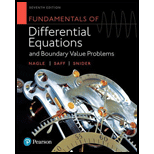
Concept explainers
Rocket Flight. A model rocket having initial mass
where
Want to see the full answer?
Check out a sample textbook solution
Chapter 3 Solutions
Pearson eText Fundamentals of Differential Equations with Boundary Value Problems -- Instant Access (Pearson+)
- Find area of the secarrow_forwardConsider the linear system whose augmented matrix is [1 1 1 1 1] 1 2 3 4 5 Identify which variables are basic and which variables are free, and then give the general solution of this system by expressing the basic variables in terms of the free variables. Show all of your work.arrow_forward-0-3-0-8 10 = = 5 Determine if w can be written as a linear combination of V1, V2, and v3. Show all of your work and justify your conclusions.arrow_forward
- Q1.2 1 Point Which of the following best describes Span O a point two points a line O a plane O all of R³ Save Answer Q1.3 1 Point Which of the following best describes Span O a point two points a line O a plane O all of R³ Save Answer Q1.4 1 Point Which of the following best describes Span O a point O three points a line O a plane O all of R³ Save Answerarrow_forwardi need help pleasearrow_forwardQuestion 4 Find an equation of (a) The plane through the point (2, 0, 1) and perpendicular to the line x = y=2t, z=3+4t. 3t, (b) The plane through the point (3, −2, 8) and parallel to the plane z = x+y. (c) The plane that contains the line x = parallel to the plane 5x + 2y + z = 1. 1+t, y2t, z = 43t and is (d) The plane that passes through the point (1,2,3) and contains the line x = 3t, y=1+t, and z = 2 – t. (e) The plane that contains the lines L₁ : x = 1 + t, y = 1 − t, z = = L2 x 2s, y = s, z = 2. 2t andarrow_forward
- Algebra & Trigonometry with Analytic GeometryAlgebraISBN:9781133382119Author:SwokowskiPublisher:Cengage
 Algebra: Structure And Method, Book 1AlgebraISBN:9780395977224Author:Richard G. Brown, Mary P. Dolciani, Robert H. Sorgenfrey, William L. ColePublisher:McDougal Littell
Algebra: Structure And Method, Book 1AlgebraISBN:9780395977224Author:Richard G. Brown, Mary P. Dolciani, Robert H. Sorgenfrey, William L. ColePublisher:McDougal Littell College Algebra (MindTap Course List)AlgebraISBN:9781305652231Author:R. David Gustafson, Jeff HughesPublisher:Cengage Learning
College Algebra (MindTap Course List)AlgebraISBN:9781305652231Author:R. David Gustafson, Jeff HughesPublisher:Cengage Learning 



